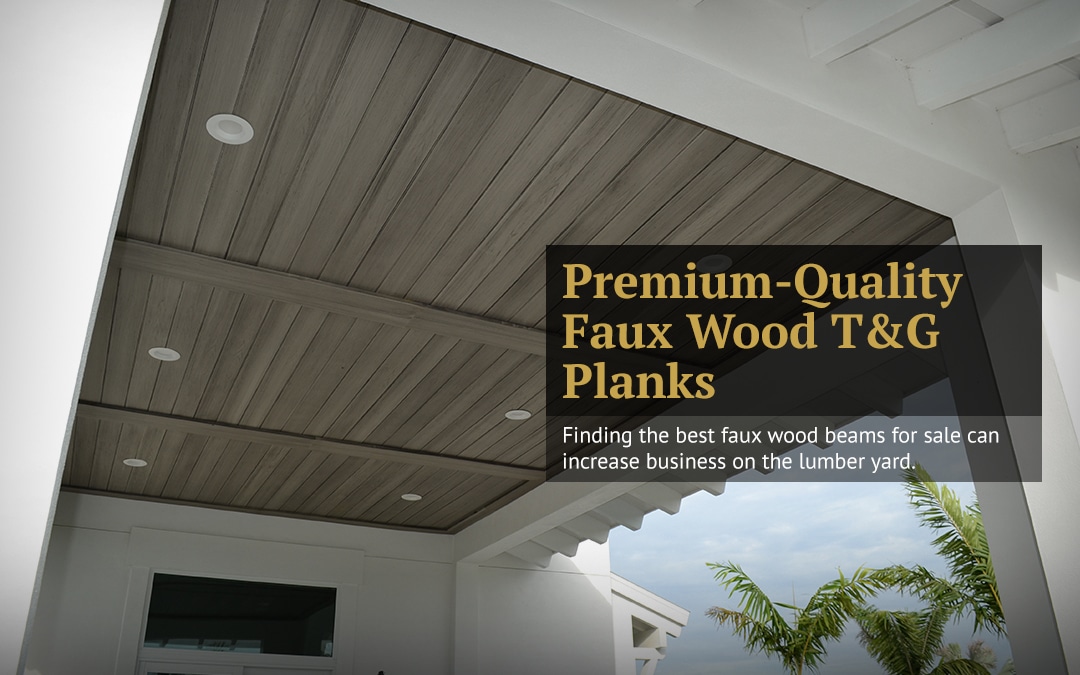Tags: Faux Wood, Faux Wood Beams, Faux Wood Beams for Ceiling, Faux Wood Ceiling Beams, Faux Wood Planks
Have you ever wanted to install wood ceilings in your home but not wanted to pay the money it takes to get real wood planks? Do you cringe at the thought of having to maintain wood planks for the next twenty years of your life? If this sounds familiar, you should take a look at faux wood tongue and groove planks.
There are a lot of excellent faux wood beams for sale that perfectly mimic the look of real wood. You won’t have to deal with the expense and fuss of maintaining them, and they’re simple enough to install yourself. Read on to learn more about faux wood planks and why you should consider them for your next renovation project.
What Are Tongue and Groove Planks?
Tongue and groove planks are an easy way to install wood ceilings or floors in your house without the hassle of filling a thousand nail holes. These boards are cut with two individual sides: a tongue side and a groove side. This helps each of the boards to snap together in place, interlocking your surface into one solid piece.
The tongue side of the board has a small center section that extends out along the edge of the board. It usually has a slight bulge or lip on one side to hold it into the groove on its neighboring board. The groove side features a cutout on its long edge matching the tongue on the opposite side, giving the tongue a place to snap into to hold the pieces together.
What Is Faux Wood?
Faux wood is made from polyurethane foam, but has the same look and feel as genuine wood. Manufacturers take impressions of real wood planks to capture their unique ridges, whorls, and uneven edges. They use these impressions to cast their faux wood planks so you get a real wood look without all the hassle.
Because faux wood is made from polyurethane, it is effectively impervious to changes in temperature and humidity. Each plank is carefully painted to resemble genuine wood, including changes in grain color, knots, and cracks. And all your faux wood planks will blend smoothly together, unlike real wood, which can have jarring changes in color.
Benefits of Using Faux Wood
There are a number of benefits of using faux wood, beginning with its moisture resistance. Wood will expand and contract with changes in temperature and humidity, causing it to bow, buckle, and gap. Faux wood will stay one consistent size, so you won’t have to worry about any of those issues.
Faux wood is a lot lighter than real wood planks, making it better for use on ceilings and walls. It’s easy to install yourself so you don’t have to pay for expert labor. And, as we’ll discuss in a moment, it’s much more affordable in the long run than real wood.
Cost of Real Wood Tongue and Groove Planks
Many real wood tongue and groove planks run somewhere between $2 and $3.50 per square foot. If you’re working with an area that’s around 300 square feet, you’ll pay between $600 and $1,000, depending on what material you choose. But the material cost is only the beginning of your expenses with real wood planks.
First, you’ll need to hire expert labor to install the wood for you, setting you back about $600 or $800. Then you’ll need to pay to have the ceilings cleaned and refinished every few years. That will cost a few hundred dollars each time, which can accumulate into thousands lost over the lifetime of the panels.
Cost of Faux Wood Tongue and Groove Planks
The upfront costs of faux wood tongue and groove planks will be a little more than real wood planks. Faux wood planks tend to run about $4 per square foot, depending on what finish you choose. If you’re covering a 300-square-foot area, you’ll have to pay about $1,200 upfront.
But faux wood tongue and groove boards are so easy to install, you can manage it yourself in a weekend. No paying a contractor to come put in your new ceiling or wall and then watching over their shoulder the whole time to make sure it’s done right. These boards are also maintenance-free, so you’ll never have to worry about them again once they’re installed.
Installing Tongue and Groove Planks
Installing faux wood tongue and groove planks is a snap – quite literally! You’ll want to start on one end of your room and place your first board with the groove side facing the wall. Nail the board in place, being sure to nail into a framing stud or other solid support.
Line your next board up with the groove side facing your previous board and use a hammer and a piece of scrap wood to gently tap it into place. You may need to use special clips attached to metal brackets to hold your boards in place. Continue snapping each board into place and securing it to the ceiling until your whole room is covered.
Find Premium Quality Faux Wood Beams for Sale
Faux wood planks can be a great way to manage tongue and groove ceilings. They are cheaper and require less maintenance in the long run, and they are easy enough to install yourself. Pick out a finish you like today and get a durable, wood-look finish that will last!
If you’d like to find the best faux wood beams for sale, check out the rest of our site at Diamond Resin Products. We sell wood-look tongue and groove ceiling planks by the foot to fit all your renovation needs. Shop our planks today and start creating a more beautiful, natural look for your home.

